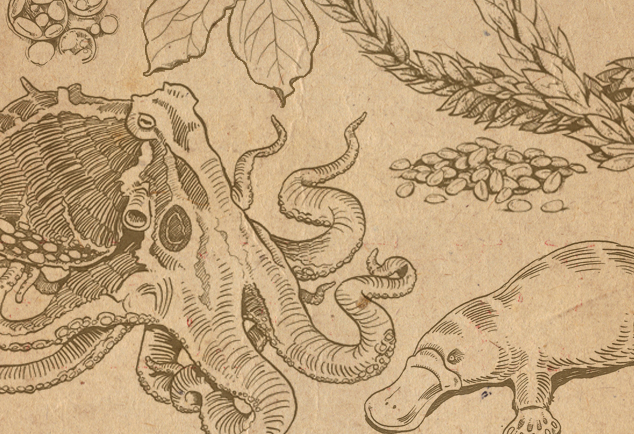
Curious genomes
All living things are made from the same stuff – DNA – but some genomes really show off the wonderful weirdness of Nature

People sequence the genomes of living creatures for lots of reasons: to see how we could make them more nutritious (plants) or tastier (animals), to see if they can be useful to us (bacteria) or to find out why they’re sick (humans). Sometimes we sequence them just because we’re curious, and we can.
There are millions of species living with us on this planet – too many to fit in a family album, and quite enough to show how little we know. For example, the Tara Oceans expedition gathered plankton samples from a couple of hundred stops on the 360 million km2 of ocean covering our world. Sequencing those samples has revealed 40 million novel genes so far. Analysing them and trying to figure out which new species they belong to is an exercise in wonder and humility.
Genome data at EMBL-EBI
When people publish genomics research on any species, they send their results to public databases like the European Nucleotide Archive (ENA). Scientists working for the Ensembl genome browser combine hard-earned knowledge from many studies carried out by laboratories around the world into a single, integrated resource. They carefully plot new information against a reference sequence for each species, and make it available for anyone to use, any time, free of charge.
The Ensembl team comes across weird genomes every day. For this special issue on curiosity, they were kind enough to share a selection of their favourites.

Animals
Platypus, Ornithorhynchus anatinus
The platypus gets plenty of attention for its odd appearance, egg laying and venomous legs. But did you know it also has five pairs of sex chromosomes? One pair is similar to the single pair of sex-determination chromosomes found in humans, and another is similar to that found in birds. That link between birds and mammals is certainly food for thought… but why so many chromosomes, do you think?
Read more about the platypus genome.
Explore the platypus genome.
California two-spot octopus, Octopus bimaculoides
This boneless, clever creature has massive expansions in two ‘families’ of genes, one of which regulates – unsurprisingly – neuronal development. Genes involved in such complex functions often have copies (gene families), which gives a bit of genetic wiggle-room when things go wrong. Scientists used to think the protocadherin and C2H2 gene families (involved in neuronal development and gene regulation, respectively) were only expanded in vertebrates. Is it the beautiful coordination of eight arms, or the highly developed escape artistry that has demanded these expansions?
Read more about the octopus genome.
Explore the octopus bimaculoides genome.
Sea urchin, Strongylocentrotus purpuratus
The genome of this spiky, slow-moving ‘hedgehog of the sea’ has an unusually large number of gene families involved in its immune response. It also has a vast collection of pathogen-recognition proteins. Like the two-spot octopus, it has genes that you’d normally think were just for vertebrates – including orthologs (gene cousins) to human genes associated with disease, vision, hearing, balance and sensing chemical stimuli. Applications for health, anyone?
Read more about the sea urchin genome.
Explore the sea urchin genome.
Algae
Galdieria sulphuraria
This species of red algae is an acid- and heat-loving extremophile. It gives an interesting example of “horizontal gene transfer”. What’s that? Well, say you were swimming in a lake, and as you glided along your genome collected some new genes from the lily pads in the water. Pretty weird, right? That’s horizontal gene transfer. It doesn’t usually happen between animals and plants – it’s more common among unicellular organisms, like bacteria. To survive in hostile environments, extremophiles need specialised genes that have not evolved in the Galdiera suphuraria lineage. Instead, this alga has gained its ability to resist acid and heat by borrowing genes from extremophillic bacteria.
Read more about the red algae genome.
Explore the Galdieria sulphuraria genome.
Plants
Wheat, Triticum aestivium
You may not think wheat is particularly weird when you’re tucking into your toast, but did you know that wheat is hexaploid? That means it has six copies of each chromosome (humans have two of each). This brings its genome to a whopping 17 giga base pairs (17,000,000,000 bp) long: five times the size of the human genome. How did it get this big? Modern bread wheat is actually derived from three different species that have cross-bred – and it retains the genetic material of all three ancestors. Because of that, most of its genes exist in several copies, which have similar sequence and function. That makes the bread-wheat genome one of the most difficult to decipher and modify, for example to make it resistant to drought.
Read more about the wheat genome.
Explore the wheat genome.
Ensembl is waiting for…
Paris japonica
This slow-growing, octoploid mountain flower has the largest genome of all. It consists of 149 giga base pairs (or 50 times larger than a human genome) and 40 chromosomes. Scientists don’t fully understand why some organisms have evolved huge genomes, or what has enabled these species to survive in spite of the hard work of maintaining a huge genome.
Find out more about the upper limit to genome size.
– Ends –
This post was originally published on EMBL-EBI News


